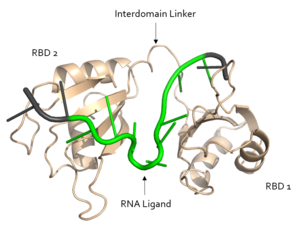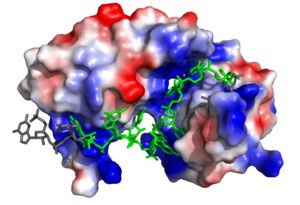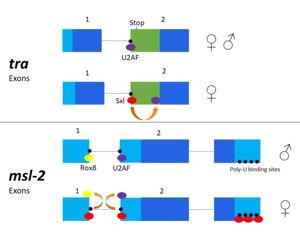Background
Sex Lethal Protein (Sxl) is a splicing repressor in the male developmental pathway of sex determination of the common fruit fly, Drosophila melanogaster[1]. regulates alternative splicing pathways to promote the expression of female sex-linked proteins. In eukaryotes, splicing is carried out via the spliceosome, a ribozyme-protein complex which binds to the 5’ and 3’ splice sites. As Sxl is a splicing repressor, it prevents the binding of the U2AF and U1 subunits of the spliceosome at their respective splice sites, which represses the alternative splicing mechanism[2]. As a result, the fruit fly expressing Sxl will produce mRNA transcripts encoding proteins for the female developmental pathway[1].
Significance

Figure 1. Structural overview of Sxl. RNA ligand colored in green is recognized and bound, while RNA ligand colored in grey is not bound. Image created in PyMol. Structure shown is
PDB:1b7f.
The Sxl RNA splicing targets encode for the transformer (tra) and the male-sex lethal (msl-2) proteins. Tra is a splicing activator for the female developmental pathway, and msl-2 modulates X chromosome application in male fruit flies. The mechanism for how Sxl targets these pathways differs slightly. In both mechanisms, Sxl occupies the 3' splice site and prevents U2AF from binding. This causes the U2AF splicing factor to bind at a downstream splice site encoding proteins in the female developmental pathway. In msl-2 targeting, Sxl also blocks the binding of another regulatory splicing factor, Rox8, and the U1 snRNP at the 5’ splice site[2]. Sxl can also control its own splicing pattern to conserve female expression. It does so by binding to Exon 3 of its own RNA and creating an RNP complex to eliminate this exon. After removal of Exon 3, Sxl becomes active and female expression is maintained.
Structure

Figure 2. Three-dimensional representation of Sex-lethal protein showing the electropositive binding pocket and the bound RNA ligand. Pre-mRNA residues binding to Sxl shown in green, non-binding residues shown in grey. Structure shown is
PDB:1b7f. Image created in PyMol.
Sxl is composed of two asymmetric RNA binding domains (RBD1 and RBD2) which recognize a poly-uridine site in the pre-mRNA transcript[1]. Each RBD is comprised of two alpha helices and one antiparallel four-stranded β sheet[1] (Fig. 1). The β sheets face each other, lining the electropositive V-shaped cleft[1]. The inter-domain linker forms a distorted 310 helix which helps form the V-shaped cleft into which the pre-mRNA sequence binds[1][3]. Sxl binds to UGUUUUUUU sequence of GUUGUUUUUUUU in the tra pre-mRNA[1][3]. RBD1 binds U6-U11 and RBD2 binds U3, G4, and U5. Although the two RBDs do not interact with each other, this nine-ribonucleotide sequence must be recognized continuously to allow Sxl to bind, preventing U2AF from binding at the 3’ splice site[1]. The binding of Sxl to the pre-mRNA occurs in an electropositive pocket due to extensive interactions with the RNA phosphate backbone and negatively charged residues[1]. Since Sxl binds primarily with the phosphate backbone, the protein residues are not highly conserved.
Alternative Splicing Pathways

Figure 3. 2-dimensional representation of alternative splicing repression by Sxl on the
tra and
msl-2 genes.
The alternative splicing pathways of Sxl differ, but both involve repression at the 3' splice site[1][3]. When Sxl targets msl-2, the first intron is retained[3]. However, the retained intron is in the 5' UTR and does not affect the reading frame[3].
Structural Basis for Recognition of Poly-U Sequences
The structural interactions with regards to the targeting of the 5' splice site and of its own mRNA transcript are much less understood than the competition of Sxl with U2AF at the 3' splice site. All the RNA-protein interactions described here refer to tra pre-mRNA-Sxl interactions.
The is crucial to pre-mRNA binding; a mutation of Arg252 to alanine eliminated the ability of Sxl to bind RNA[1].
The ligand pre-mRNA sequence forms a characteristic at U5, U6, and U7. This interaction is stabilized by π stacking between the G4 and U5 nucleotides and residues , respectively[1]. The nucleobases are exposed to residues on Sxl due to the 2’ endo conformation of all the nucleotides except for U8, which maintains a 3’ endo conformation[1].
The U6 residue is recognized as part of the RNA by [1]. The Arg195 amide hydrogen-bonds to the O2' of U6 and the U6 N3H hydrogen bonds to the Arg195 carbonyl oxygen[1].
In the RNA , the U7 and U8 bases are involved in π , stabilizing the unusual 3' endo conformation of the U8 sugar[1]. U8 is further stabilized via hydrogen bonding [1]. The amine group of U8 hydrogen bonds to the the carbonyl oxygens of both Ser165 and Tyr166 [1].
is recognized by the interdomain linker [1]. This interaction is a salt bridge between the Asn130 side chain and a phosphate oxygen of U9[1]. U9 is further stabilized by a second between the U9 O2' and the side chain of Arg202 and the U9 O4' and the Lys197 side chain[1].
U9 facilitates the stabilization of U10, which is also recognized by the interdomain linker. to form a salt bridge.
U11 is recognized by Arg155. The O2' of U11 to form a hydrogen bond[1].
The above interactions are relevant in that Sxl recognizes the specific pre-mRNA based mostly on interactions with the sugar-phosphate backbones[1]. Many proteins with RNA recognition motifs are specific in the interactions they form with the bases of the RNA recognized. In contrast, Sxl has a high specificity despite primarily interacting with the phosphate backbone.



